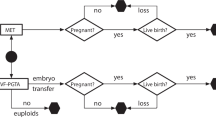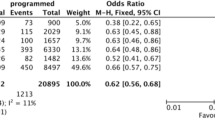Abstract
Purpose
Karyotype is a well established technique in the study of spontaneous miscarriages but is associated with selective overgrowth of maternal cells and other culture artefact (spp) such as tetraploidy, which could mask the true karyotype of the conceptus.
Methods
328 cases of pregnancy losses were studied by karyotype and Multiplex Ligation Dependent Probe Amplification technique. Touch FISH performed in non-cultured cells was used to evaluate the ploidy complement and sex discrepancies using centromeric probes for chromosomes X, Y and 18.
Results
Touch FISH confirmed 13 cases of maternal contamination, identified a triploidy and a monosomy X. True tetraploidy was confirmed in 7/14 cases studied.
Conclusion
Touch FISH protocol is extremely accurate in the distinction of genuine mosaicism from tissue culture artifacts namely in cases with suspicion of tetraploidy and can be used to confirm maternal cell contamination in cases with sex discrepancy between karyotype and MLPA.

Similar content being viewed by others
References
Doria S, Carvalho F, Ramalho C, Lima V, Francisco T, Machado AP, et al. An efficient protocol for the detection of chromosomal abnormalities in spontaneous miscarriages or foetal deaths. Eur J Obstet Gynecol Reprod Biol. 2009;147:144–50.
Goddijn M, Leschot NJ. Genetic aspects of miscarriage. Baillières Best Pract Res Clin Obstet Gynaecol. 2000;14:855–65.
Karaoguz MY, Nas T, Konac E, Ince D, Pala E, Menevse S. Is cytogenetic diagnosis of 46, XX karyotype spontaneous abortion specimens erroneous? Fluorescence in situ hybridization as a confirmatory technique. J Obstet Gynaecol Res. 2005;31:508–13.
van den Berg C, Van Opstal D, Polak-Knook J, Galjaard RJ. (Potential) false–negative diagnoses in chorionic villi and a review of the literature. Prenat Diagn. 2006;26:401–8.
Bell KA, Van Deerlin PG, Haddad BR, Feinberg RF. Cytogenetic diagnosis of “normal 46, XX” karyotypes in spontaneous abortions frequently may be misleading. Fertil Steril. 1999;71:334–41.
Jobanputra V, Sobrino A, Kinney A, Kline J, Warburton D. Multiplex interphase FISH as a screen for common aneuploidies in spontaneous abortions. Hum Reprod. 2002;17:1166–70.
Boue J, Bou A, Lazar P. Retrospective and prospective epidemiological studies of 1500 karyotyped spontaneous human abortions. Teratology. 1975;12:11–26.
Vorsanova SG, Kolotii AD, Iourov IY, Monakhov VV, Kirillova EA, Soloviev IV, et al. Evidence for high frequency of chromosomal mosaicism in spontaneous abortions revealed by interphase FISH analysis. J Histochem Cytochem. 2005;53:375–80.
Bruno DL, Burgess T, Ren H, Nouri S, Pertile MD, Francis DI, et al. High-throughput analysis of chromosome abnormality in spontaneous miscarriage using an MLPA subtelomere assay with an ancillary FISH test for polyploidy. Am J Med Genet A. 2006;140:2786–93.
Kirchhoff M, Rose H, Lundsteen C. High resolution comparative genomic hybridisation in clinical cytogenetics. J Med Genet. 2001;38:740–4.
Lomax B, Tang S, Separovic E, Phillips D, Hillard E, Thomson T, et al. Comparative genomic hybridization in combination with flow cytometry improves results of cytogenetic analysis of spontaneous abortions. Am J Hum Genet. 2000;66:1516–21.
Diego-Alvarez D, Rodriguez de Alba M, Cardero-Merlo R, Diaz-Recasens J, Ayuso C, Ramos C, et al. MLPA as a screening method of aneuploidy and unbalanced chromosomal rearrangements in spontaneous miscarriages. Prenat Diagn. 2007;27:765–71.
Gustashaw K. Chromosome stains. In the ACT cytogenetics laboratory manual, 2nd edition. New York, 1991.
Eiben B, Bartels I, Bahrporsch S, Borgmann S, Gatz G, Gellert G, et al. Cytogenetics analysis of 750 spontaneous abortions with the direct preparation method of chorionic villi and its implications for studying genetic causes of pregnancy wastage. Am J Hum Genet. 1990;47:656–63.
Daniely M, Aviram-Goldring A, Barkai G, Goldman B. Detection of chromosomal aberration in fetuses arising from recurrent spontaneous abortion by comparative genomic hybridization. Hum Reprod. 1998;13:805–9.
Hassold T, Chen N, Funkhouser J, Jooss T, Manuel B, Matsuura J, et al. A cytogenetic study of 1000 spontaneous abortions. Ann Hum Genet. 1980;44:151–78.
Rai R, Regan L. Recurrent miscarriage. Lancet. 2006;368:601–11.
Morales C, Sanchez A, Bruguera J, Margarit E, Borrell A, Borobio V, et al. Cytogenetic study of spontaneous abortions using semi-direct analysis of chorionic villi samples detects the broadest spectrum of chromosome abnormalities. Am J Med Genet A. 2008;146A:66–70.
Azmanov DN, Milachich TV, Zaharieva BM, Michailova GI, Dimitrova VG, Karagiozova ZH, et al. Profile of chromosomal aberrations in different gestational age spontaneous abortions detected by comparative genomic hybridization. Eur J Obstet Gynecol Reprod Biol. 2007;131:127–31.
Bartels I, Hansmann I, Eiben B. Excess of females in chromosomally normal spontaneous abortuses. Am J Med Genet. 1990;35:297–8.
Jarrett KL, Michaelis RC, Phelan MC, Vincent VA, Best RG. Microsatellite analysis reveals a high incidence of maternal cell contamination in 46, XX products of conception consisting of villi or a combination of villi and membranous material. Am J Obstet Gynecol. 2001;185:198–203.
Lathi RB, Milki AA. Tissue sampling technique affects accuracy of karyotype from missed abortions. J Assist Reprod Genet. 2002;19:536–8.
Schluth C, Doray B, Girard-Lemaire F, Favre R, Flori J, Gasser B, et al. Prenatal diagnosis of a true fetal tetraploidy in direct and cultured chorionic villi. Genet Couns. 2004;15:429–36.
Montanari D, Haefliger C, Mollica ME, Banares V, Zelaya G. Prenatal diagnosis of a diploid–tetraploid fetus. Acta Obstet Gynecol Scand. 2000;79:1026.
Sharma A, Paliwal P, Dadhwal V, Sharma Y, Deka D. Rare finding of 2n/4n mixoploidy in mother and fetus with severe immune hydrops. Cytogenet Genome Res. 2009;124:90–3.
Author information
Authors and Affiliations
Corresponding author
Additional information
Capsule
Touch FISH as an effective approach for the study of pregnancy losses with maternal cell contamination or with mosaic tetraploid cells present in the karyotype.
Rights and permissions
About this article
Cite this article
Dória, S., Lima, V., Carvalho, B. et al. Application of touch FISH in the study of mosaic tetraploidy and maternal cell contamination in pregnancy losses. J Assist Reprod Genet 27, 657–662 (2010). https://doi.org/10.1007/s10815-010-9460-1
Received:
Accepted:
Published:
Issue Date:
DOI: https://doi.org/10.1007/s10815-010-9460-1




